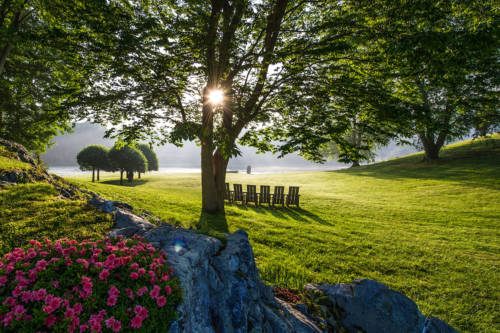
New York State of Mind? Plan the Perfect Getaway to Innisfree Garden
On a scenic drive about 90 miles north of New York City, Innisfree Garden, named after the timeless poem by William Butler Yeats, offers the perfect retreat from stressful city life. Further still: it’s one of the best gardens in the world.
Set among rolling hills and deep woodlands, Innisfree amazes with its sweeping natural landscape– 185 acres in all– and its tranquil views of a very large glacial lake. Originally Innisfree was a densely wooded private estate in Millbrook, NY, owned in the 1920’s by artist Walter Beck and his wife Marion Burt Beck, a devoted gardener and heiress. The Becks gradually shaped the lake and surrounding hills into gardens that were influenced by their fascination with Asian art; in particular, Chinese landscape paintings by the famous 8th Century poet and artist Wang Wei.
Wang Wei’s individual landscapes were enclosed, like the sides of a cup, and Walter Beck called them “cup gardens”– his idea of the three-dimensional pictures he wanted to create in his own garden.
An Iconic Stroll Garden
Working closely with the distinguished landscape architect Lester Collins over several decades, the Becks developed Innisfree so that a series of cup gardens would provide “moments” to experience along the pathways by the lake.
Beck and Collins often followed the practical advice given in a much-revered, 1,000-year-old Japanese garden handbook (called Sakuteiki, or the Secret Garden Book), which Collins had studied in Japan after becoming the Dean of Harvard’s School of Landscape Architecture. The handbook teaches gardeners to study nature and the features of the land first, then select and and distill their own ideas– building the essence, rather than copying other gardens.
Innisfree became a public garden under Collins’ direction in 1960. The 40-acre lake became “the floor” of the total landscape, with rocky cliffs and woodland hills framing it on every side– a sort of giant cup garden with little cup gardens inside, shaped by rocks, plants, and water.
Collins describes how Eastern garden design influenced the Innisfree Garden in his book Innisfree: An American Garden, which was published shortly after his death:
“Western gardens are usually designed to embrace a view of the whole. Little is hidden. The garden, like a stage set, is there in its entirety, its overall design revealed in a glance…The traditional Chinese garden is usually designed so that a view of the whole is impossible. The Chinese Garden requires a stroll over serpentine, seemingly aimless arteries. The observer walks into a series of episodes, like Alice through the looking glass….”
The Importance of Rocks
As you stroll around the lake, the placement of dark grey, weather-worn rocks is striking. Sometimes there’s a single vertical rock; other times there are rocks built into horizontal ledges, waterfalls, or staircases; or the stones are free-standing as naturally sculpted animal forms. Some are gigantic monolithic stones, others seem delicately balanced.
According to Kate Kerin, Landscape Curator at Innisfree, there was a huge supply of rocks– a veritable “rock nursery”– collected from those deposited by the glacier. The rocks are made from a combination of sandstone, limestone, granite, and quartz in all shapes and sizes, up to five tons. Beck hired crews to pull them from the hills using mules or transferring them across the lake wrapped in quilts on huge scows. Later on, when Collins took over, the rocks were moved by a front-end loader.
Only the best rocks were selected for careful placement– a single rock could be its own cup garden. Emblematic of the garden are the Owl Rock, Turtle Rock, and Dragon Rock. They stand together on a point of land, looking out over the water like ancient sentinels.
Dramatic Water Features
One of the most startling experiences in the garden is the Mist Waterfall, suddenly appearing above a sharp vertical cliff. The mist rises above the cliff wall looking totally natural, but in fact a lot of special engineering and management is required to produce the very fine droplets. The plume of mist shimmers and moves in the breeze, while small waterfalls flow down the sheer rocks and into an underground pipe, a hidden drain into the lake.
Low-maintenance Native Plants
Collins understood the different ecosystems in various areas of the garden and over time he adjusted native plantings so that they could thrive in the right place. One example: the native Rose Mallow (Hibiscus lasiocarpos) in the Bog Garden and along the shorelines of the lake. Collins writes that by mowing down spring plants near the mallows, opening up the space, the mallows happily spread on their own.
Another stunning native plant, Joe Pye Weed (Eutrochium purpureum), stands six feet tall amidst a lawn that is carved by a downhill serpentine stream. In fact, about forty percent of the flowers at Innisfree are native wildflowers placed where they can flourish.
To help identify the wildflowers, several years ago Innisfree’s Executive Director, Oliver Collins, hired Marilyn Katz and George Petty to develop a seasonal “Catalog of Wildflowers” (available online with images). The Catalog now lists about 125 species of plants that are native to Dutchess County and nearby areas. The authors note that new unlisted species seem to crop up all the time so the effort is ongoing.
***
On Saturday, September 24, Innisfree will host a plant sale and an Open Day in partnership with the Garden Conservancy. For detailed information and tickets, visit the Garden Conservancy’s website.





































